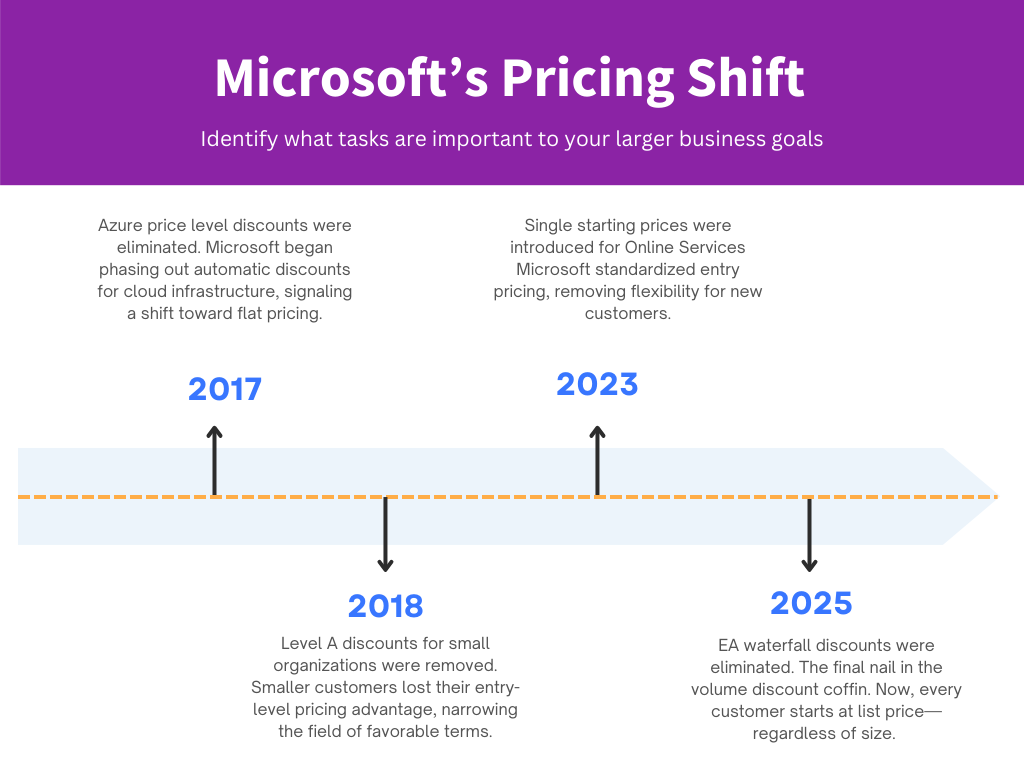Microsoft’s latest licensing overhaul is being marketed as “pricing simplification.” Charming euphemism, isn’t it? But if you manage the P&L, it feels less like simplification and more like a budget grenade lobbed into your renewal cycle. The elimination of Enterprise Agreement (EA) volume discounts isn’t just a pricing tweak—it’s a strategic shift that puts your IT budget on the defensive. If you’re wondering how to adapt, The IT Strategists breaks down what Microsoft changes mean for your renewal strategy—and how to regain leverage in 2025 and beyond.
Microsoft’s Official Line: The PR Spin
On paper, Microsoft frames this change as a move toward transparency and efficiency. Their stated goals include:
- “Aligning with industry-standard cloud pricing”
Microsoft claims this brings their pricing model in line with other cloud providers. In reality, it removes the tiered incentives that made EA pricing attractive to large organizations. - “Simplifying licensing”
The company suggests that eliminating discount tiers makes licensing easier to understand. What it really does is remove automatic benefits and shift the burden of negotiation onto the customer. - “Helping partners focus on value-added services instead of explaining price tiers”
Translation: Microsoft wants partners to sell more services—not spend time justifying pricing structures. It’s a strategic pivot that benefits Microsoft’s ecosystem, not your budget.
The Reality Behind Microsoft’s Pricing Shift
This isn’t a sudden epiphany about simplicity. It’s a long-term strategy to consolidate pricing control and reduce customer leverage. Here’s the timeline:
2017: Azure price level discounts were eliminated. Microsoft began phasing out automatic discounts for cloud infrastructure, signaling a shift toward flat pricing.
2018: Level A discounts for small organizations were removed. Smaller customers lost their entry-level pricing advantage, narrowing the field of favorable terms.
2023: Single starting prices were introduced for Online Services Microsoft standardized entry pricing, removing flexibility for new customers.
2025: EA waterfall discounts were eliminated. The final nail in the volume discount coffin. Now, every customer starts at list price—regardless of size.
The pattern is clear. Microsoft is systematically removing built-in benefits and replacing them with a negotiation-first model. Your leverage is shrinking, while theirs grows.

Why This Matters for Your Renewal Strategy
In the old EA model, seat volume translated directly into savings. That’s no longer the case. Here’s what it means for your next renewal:
- The balance of power shifts: You’re entering negotiations with fewer guaranteed advantages. Microsoft holds the cards, and you’ll need to play smarter to protect your budget.
- Your outcome depends on negotiation: Discounts won’t be automatic—they’ll be earned. Microsoft will evaluate your strategic value, platform commitment, and negotiation posture before offering any relief.
- Strategy matters more than discounts: A well-informed licensing strategy beats a legacy discount every time. You need to audit your usage, identify underutilized services, and align your licensing with actual business needs. That insight becomes your new leverage.
The CSP Angle: A Rising Alternative
Ironically, Microsoft’s push to simplify EA pricing makes the Cloud Solution Provider (CSP) program more attractive—especially for mid-sized organizations. CSPs can offer:
More flexible commercial terms: CSP agreements often include monthly billing, adjustable seat counts, and fewer long-term commitments.
Multi-year commitments that mirror EA benefits: Some CSPs offer extended terms that resemble EA contracts, but with more agility and responsiveness.
Competitive pricing now that EA discounts are gone: With EA pricing flattened, CSPs can match or beat Microsoft’s direct pricing—sometimes with added support and services.
If you haven’t explored CSP options recently, now’s the time. The landscape has shifted, and CSPs may offer flexibility and savings EA no longer guarantees.
The Bottom Line: Don’t Buy the Spin
Microsoft isn’t simplifying pricing for your benefit—they’re streamlining it for theirs. By removing automatic discounts, they’re forcing customers to negotiate from a weaker position. The question isn’t why they’re doing it—you know that now. The real question is: what are you going to do about it?
Coming up in Part 3: How to prepare for renewal, what negotiation tactics actually work, and how to protect your IT budget from Microsoft’s “simplification.”
Need help building your licensing strategy or exploring CSP alternatives? Schedule a free consultation with an expert at http://www.theITstrategists.com and get tailored guidance before your next renewal.

